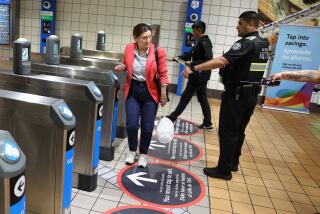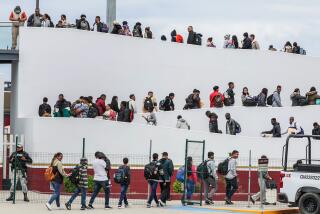Global Entry program for fliers: You don’t have to be a VIP
Finally, I am a card-carrying member of the Global Entry program. After months of procrastination, I may now be able to enter the country more quickly. But that wasn’t my primary goal. So why bother?
I confessed in a Dec. 30 On the Spot column that I had PreCheck envy. That’s the Transportation Security Administration program that allows frequent fliers to speed through security. Because I’m a leisure traveler and generally fly the lowest-cost airline, the chance of my getting elite status with any carrier is about as likely as the Dodgers making the 2013 World Series.
That’s where Global Entry, administered by U.S. Customs and Border Protection, comes in. For $100 for five years, you not only get to whisk through U.S. customs, but as a bonus you also get PreCheck status, which means you don’t have to take off your belt, shoes or jacket or remove your laptop and liquids from your carry-on.
That’s what appealed to me. I had dawdled because I found the Global Entry website balky, but after an interview in December with John Pistole, the administrator of the TSA, and a couple of emails from readers telling me to quit whining, I vowed I’d finally get it done.
The conditional approval came May 9. Woo-hoo. But — and there’s always one, isn’t there? — the final step in the process is an in-person interview, and no appointments were available until Aug. 6. Bummer — and I said so in a blog post.
I soon heard from Michael Friel, the media division director of the Office of Public Affairs for U.S. Customs and Border Protection, who said he could get me through the process faster (I declined) and offered me an interview with John Wagner, acting deputy assistant commissioner for CBP (I accepted). In that interview, Wagner said the number of Global Entry applications had grown to about 50,000 a month. Not everyone is accepted — if you’ve had legal troubles or if you’ve violated, say, agricultural rules in returning to the country, you will be disqualified — but that’s still a lot of in-person interviews.
More interview slots had been added, Wagner said, and sometimes there were cancellations. I waited about a week after that blog post just to be fair and then jumped on the site. An interview was available just four days later (probably a cancellation), so I grabbed it.
Here are some things I learned about the program from the interview and from readers:
— If you get arrested, you lose your Global Entry privileges. “So just don’t get arrested,” the officer told me. Not planning on it.
— My Global Entry card, about the size of a driver’s license, came with a “sleeve” that is supposed to block thieves from reading the information. After a recent Spot column on “smartcard” credit cards and their security — the chips in passports and this card are similar — in which experts told me it’s unlikely that such chips can be read, I asked CBP why it was issued. I didn’t get one with my passport. So far, CBP has not been able to explain this.
— Getting those PreCheck privileges doesn’t just happen, reader Sarah Patterson, who has had Global Entry for some time, told me. You must enter your Global Entry number into your airline account. Not every airline participates; Alaska, American, Delta, United, US Airways and Virgin American do. (Not every airport does either.) Two readers told me they’d had difficulty getting their number to “stick” on their accounts on certain airlines and had to re-enter it each time. It’s important you do that because your boarding pass then will indicate that you have this privilege.
— You probably won’t need the Global Entry card unless you’re crossing into Mexico or Canada by land or sea. A pamphlet I received at the interview said the card allows you to use “the SENTRI lanes at land-border crossing with Mexico” and “NEXUS lanes with U.S.-Canada land border crossings.” Otherwise, keep your card at home in a safe place. Your driver’s license will serve you better getting through airport security and, if you’re coming back into the country by air, you will have a passport.
As I write this, I am on a plane. I’d love to tell you that I went hippety-hopping through security, but these reservations were made months ago on an airline that’s not a PreCheck member. So is it worth it? I don’t yet know. You pay the $100 fee whether you’re accepted or not. That’s steep, although spread out over five years and five trips a year, $4 a trip is worth it to me to avoid the security line striptease. (One reader suggested that because The Times paid my fee, I was dismissive of the cost. The Times didn’t pay my fee — this is a personal choice — but I still think it’s worth it.)
As with regular PreCheck, just because you’re a member of the club, you don’t necessarily get to use the program. There are times, I’m told, when I’d be directed to the regular line. Security that’s predictable loses its effectiveness.
Here’s something I can predict with a fair amount of certainty: Those who recently had to wait in long customs lines in Miami, Dallas and JFK to get through immigration, as the Wall Street Journal reported, probably think the $100 is a bargain, given the number of missed connections as a result of lines. Expect more logjams this summer, the Journal says, adding, “The best antidote for U.S. citizens, even infrequent travelers, is to enroll in CBP’s trusted traveler program called Global Entry.”
Info: https://www.globalentry.gov.
Have a travel dilemma? Write to travel@latimes.com. We regret we cannot answer every inquiry.
More to Read
Sign up for The Wild
We’ll help you find the best places to hike, bike and run, as well as the perfect silent spots for meditation and yoga.
You may occasionally receive promotional content from the Los Angeles Times.







